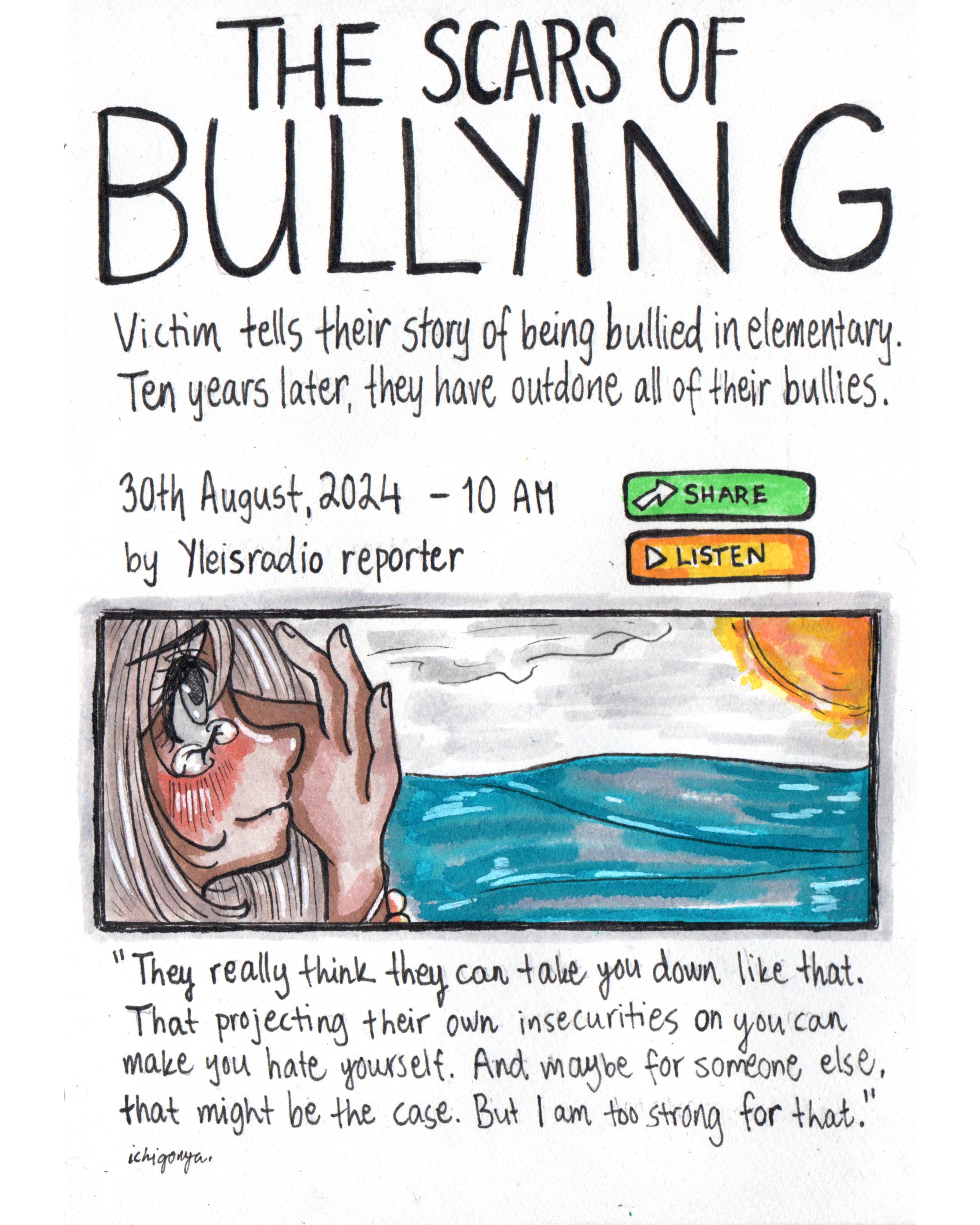Media: Conditions Apply
Throughout these past few years that I have been working on the project, I’ve reached out to various media outlets in Finland to garner some type of attention from them. So far, only one of those attempts has led to something substantial, and that was in early 2023 when the newspaper of my own county interviewed me. When I reached out to the arts journalist of the paper, I made it a point to let her know that what I was looking for was not a sob story on my abuse and trauma, but a contextual glance at my artistry, what I have turned my childhood trauma into. The journalist was interested in both me as a person and my art; she had checked out my Instagram page and blog articles and was on board with my wish of focusing on the art side of things, promising me to include the few selected scans of my illustrations. I was super excited, this was going to be the starting point of everything!
Unfortunately, though, this interview and the article that came with it turned out to be major disappointment. There were no scans of any of the illustrations and barely any mention of my art in general. I was not given the chance to read the finished piece before it was published, which is usually the protocol in cases such as mine. It was only after the editor had already accepted the paper of that day that the arts journalist reached out to me, declaring that a lot of the things we’d agreed on had had to be edited, particularly regarding my art.
interview.
The illustrations I had finished by that time had been deemed “not fit for publishing” by the editor at the very last minute. For this reason, they had decided to focus more on my personal story of being abused by my peers and my health collapsing in early adulthood as a result.
Artistic censorship comes in many shapes and sizes, but the one that frustrates me the most is censorship of illustrative artwork. For some reason, illustrations are subjected to such a ridiculous amount of scrutiny that I honestly wish we were using those resources for something a lot more important. Media outlets have no problem with publishing real-life photographs from the battlefields of the numerous wars we have going on in this world, nor with reviewing albums whose songs have lyrics so explicitly pornographic that my asexual self gets uncomfortable even reading them on paper. But an illustration with unrealistically bright red blood? Blasphemy.
⋅•⋅⋅•⋅⊰⋅•⋅⋅•⋅⋅•⋅⋅•⋅∙∘☽༓☾∘∙•⋅⋅⋅•⋅⋅⊰⋅•⋅⋅•⋅⋅•⋅⋅•⋅
The problems I have with media outlets are not limited to just artistic censorship. They extend to all kinds of censorship, particularly the kind that trauma survivors and disabled people have to go through. It’s like there are these unspoken rules that we all have to abide by when it comes to whose story is worth listening to, whose voice is worth giving attention to. And there is a word for it, too.
Inspiration porn. It is the objectification of disabled people and other chronically ill people as a source of inspiration to non-disabled people and otherwise healthy individuals simply due to the way in which they have to live their lives. There are countless of variants of inspiration porn out there, all of which are depending on the kind of disability or chronic illness the disabled person has (because it is an entirely different type of objectification that autistic people experience compared to amputees, for example). But the kind that is the most topical to this conversation is media outlets publishing the stories of trauma survivors on only one condition: that the survivor has to have been able to overcome their trauma and come out on top.
I think it’s a worthy topic of discussion to approach the inspiration porn trauma survivors have to go through from the perspective of bullying specifically. During the past decade or so, we have seen the tides shifting on the current of amplifying the voices of victims of sexual assault. The MeToo movement still continues to do a lot of good for SA survivors, and the impact it has had on victims being validated in their experiences has been immeasurable. In the recent years, I have come across multiple profile articles in various Finnish mainstream media outlets on the victims of sexual assault, where they have talked about the daily struggles of living with sexual trauma, how their life has never been the same after what happened to them. And every time I read these articles, I think about just how important and valuable it is for the victims of these stories to be heard and seen not only in what happened to them, but in their daily struggles as a traumatized person. But for reasons I still don’t fully understand, the same kind of mentality is not applied to victims of bullying.
Your story as a bullied kid is only valuable if you have grown up to be a super successful adult, if you’ve turned your suffering into something that has gotten you a lot of fame and fortune years later, if you’re able to prove to everyone that you were too strong for anyone to break you even as a kid, that you were never weak enough to let it all get to you. Those are the conditions that apply to media coverage for victims of peer abuse – and that, if anything, is definitely inspiration porn.
So yeah, I might have not gotten the kind of end result out of the interview I was so excited for two years ago. But after thinking about it long and hard, I think I might have found a solution to the problem.
Why not create my own media outlet instead?
Conspiring,
ichigonya
